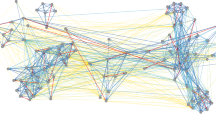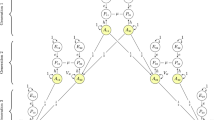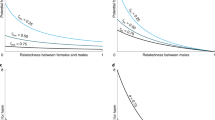Abstract
Inclusive fitness models1,2 predict many commonly observed behaviours: among humans, studies of within-household violence3, the allocation of food4,5 and child care6 find that people favour those to whom they are more closely related. In some cases however, kin-altruism effects appear to be modest7,8,9. Do individuals favour kin to the extent that kin-altruism models predict? Data on remittances sent by South African migrant workers to their rural households of origin allow an explicit test, to our knowledge the first of its kind for humans. Using estimates of the fitness benefits and costs associated with the remittance, the genetic relatedness of the migrant to the beneficiaries of the transfer, and their age- and sex-specific reproductive values, we estimate the level of remittance that maximizes the migrant worker's inclusive fitness. This is a much better predictor of observed remittances than is average relatedness, even when we take account (by means of a multiple regression) of covarying influences on the level of remittance. But the effect is modest: less than a third of the observed level of remittances can be explained by our kin-altruism model.
This is a preview of subscription content, access via your institution
Access options
Subscribe to this journal
Receive 51 print issues and online access
$199.00 per year
only $3.90 per issue
Buy this article
- Purchase on Springer Link
- Instant access to full article PDF
Prices may be subject to local taxes which are calculated during checkout



Similar content being viewed by others
References
Hamilton, W. D. The genetical evolution of social behavior. J. Theor. Biol. 7, 1–52 (1964)
Taylor, P. Inclusive fitness arguments in genetic models of behavior. J. Math. Biol. 34, 654–674 (1996)
Daly, M. & Wilson, M. Homicide and kinship. Am. Anthropol. 84, 372–378 (1982)
Gurven, M., Hill, K. & Kaplan, H. From forest to reservation: Transitions in food sharing among the Ache of Paraguay. J. Anthropol. Res. 58, 93–120 (2002)
Case, A., Lin, I.-F. & McLanahan, S. How hungry is the selfish gene? Econ. J. 110, 781–804 (2000)
Anderson, K., Kaplan, H., Lam, D. & Lancaster, J. Paternal care by genetic fathers and stepfathers. II: Reports by Xhosa high school students. Evol. Hum. Behav. 20, 433–451 (1999)
Gurven, M., Hill, K., Kaplan, H., Hurtado, A. M. & Lyles, R. Food transfers among Hiwi foragers of Venezuela: Tests of reciprocity. Hum. Ecol. 28, 171–218 (2000)
Kaplan, H. & Hill, K. Food sharing among Ache foragers: tests of explanatory hypotheses. Curr. Anthropol. 26, 223–246 (1985)
Smith, E. A., Bird, R. B. & Bird, D. W. Risk and reciprocity in Meriam food-sharing. Evol. Hum. Behav. 23, 297–321 (2002)
South Africa Integrated Household Survey: The Project for Statistics on Living Standards and Development (A Living Standards Measurement Survey of the World Bank, South African Labour and Development Research Unit, Univ. Cape Town, Cape Town, 1993); http://www.worldbank.org/html/prdph/lsms/country/za94/za94home.html.
Stevenson, A. C., Johnston, H. A., Stewart, M. I. & Golding, D. R. Congenital malformations: A report of a study of series of consecutive births in 24 centres. Bull. World Health Org. 34 (suppl.), 1–127 (1966)
Mencarini, L. An Analysis of Fertility and Infant Mortality in South Africa based on 1993 LSDS Data 109–128 Pre-conf. Proc. of Third African Population Conf. ‘African Population in the 21st Century’ (Durban, South Africa, 6–10 December 1999) (UAPS, Dakar, Senegal, 1999).
Fisher, R. A. The Genetical Theory of Natural Selection 27–30 (Clarendon, Oxford, 1930)
Grafen, A. A Theory of Fisher's Reproductive Value (St John's College, Oxford, 2004)
Kahn, K., Tollman, S., Garenne, M. & Gear, J. S. S. Who dies from what? Determining cause of death in South Africa's rural north-east. Trop. Med. Int. Health 4, 433–441 (1999)
Grafen, A. Formal darwinism, the individual-as-maximizing-agent analogy, and bet-hedging. Proc. R. Soc. 266, 799–803 (1999)
Pennington, R. & Harpending, H. The Structure of an African Pastoralist Community: Demography, History, and Ecology of the Ngamiland Herero (Clarendon, Oxford, 1993)
Fehr, E. & Fischbacher, U. The nature of human altruism—proximate patterns and evolutionary origins. Nature 425, 785–791 (2003)
South Africa Demographic and Health Survey 1998 (Preliminary Report, Department of Health, 1998); http://www.doh.gov.za/facts/1998/sadhs98/.
Posel, D. Intra-family transfers and income-pooling: A study of remittances in Kwazulu-Natal. S. Afr. J. Econ. 69, 501–528 (2001)
World Health Organization. The World Health Report, 1999: Making a Difference 90, Table 1, Statistical Appendix; http://www.who.int/entity/whr/1999/en (WHO, Geneva, 1999).
Acknowledgements
The authors contributed equally to this paper. D.P. thanks the Woodrow Wilson School at Princeton University for the post-doctoral leave supporting this research. S.B. thanks the Behavioural Sciences Program of the Santa Fe Institute for financial support. We have benefited from the contributions of R. Boyd, N. Borgerhoff Mulder, N. Folbre, H. Kaplan, R. Rowthorn and D. E. Smith.
Author information
Authors and Affiliations
Corresponding author
Ethics declarations
Competing interests
The authors declare that they have no competing financial interests.
Rights and permissions
About this article
Cite this article
Bowles, S., Posel, D. Genetic relatedness predicts South African migrant workers' remittances to their families. Nature 434, 380–383 (2005). https://doi.org/10.1038/nature03420
Received:
Accepted:
Issue Date:
DOI: https://doi.org/10.1038/nature03420
This article is cited by
-
Intra-Household and Inter-Personal Comparisons of Subjective Well-Being: Dorrit Posel
Applied Research in Quality of Life (2021)
-
Complex interactions between sperm viability and female fertility
Scientific Reports (2019)
-
Father Absence, Childhood Stress, and Reproductive Maturation in South Africa
Human Nature (2015)
-
Cooperation and Hamilton's rule in a simple synthetic microbial system
Molecular Systems Biology (2010)
Comments
By submitting a comment you agree to abide by our Terms and Community Guidelines. If you find something abusive or that does not comply with our terms or guidelines please flag it as inappropriate.



